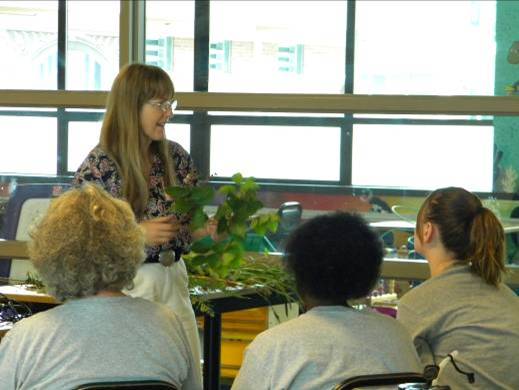Conservation Nursery Crew Begins Work at WCCW
By Graduate Research Assistant Brianna Morningred
With the completion of two hoop houses, work with the inmate crew at Washington State Correction Center for Women (WCCW) has begun. We have three inmates working with us and it is so wonderful that they all are genuinely excited to be a part of the project. The very first day Carl Elliott and I introduced ourselves and began teaching the women about the work they will be doing. One of them had horticulture experience, but regardless, conservation nursery work is a lot different than your average gardening. All three women picked up the technique quickly and were excited to get started.

WCCW conservation nursery technicians and their supervisor work in a new hoop house. Photo by B. Morningred.
We began sowing work with CAHI, also known as Castilleja hispida or Indian Paintbrush. This rare native plant species is crucial for the preservation of Puget Sound Prairies. As it is difficult to germinate successfully, we at SPP put a lot of care into sowing CAHI. In order to help the inmate technicians really understand what they are a part of, I brought them visual aids to show them where their plants would go and why what they are doing matters so much. They seemed to really appreciate knowing that their work is a part of something bigger—which is one of most important points I wanted to get across.
As of January 9, 2013, our great crew at WCCW has sown approximately 300 trays—30,000 cells—of CAHI and they are still going strong. The increasingly colder weather is making work a little more difficult but we are fortunate to have such a dedicated crew—being productive no matter what the fickle Washington weather may bring. In the next couple of weeks we’ll begin sowing WYAN or Wyethia angustifolia, the Narrowleaf Wyethia. WYAN is an essential daisy-like perennial that supports the endangered Fender’s Blue Butterfly species that are native to Washington and Oregon prairies.
In addition to learning a lot about sowing techniques, we have also organized a Lending Library so each inmate can check out one book each week for additional learning. The women have really enjoyed this opportunity as their prison library is currently closed for renovation. They have taken particular advantage of the copies of our Conservation Nursery Manual, which we have supplied for them to learn in more detail about the processes they are completing each day.
It has been a wonderful start at WCCW. We are looking forward to spring, warmer weather, and hopefully high germination rates!



 Gig Harbor, Wash.—Emphasizing the importance of sustainability, the horticulture program at
Gig Harbor, Wash.—Emphasizing the importance of sustainability, the horticulture program at  “Because each offender demonstrated a high capacity of responsibility for day-to-day farm activities, I decided to assign special projects for each lady,” Little said. “The project idea was a way for the offenders to take ownership of the farm, learn something new and educate each other on their respective projects. Being a part of the learning process was an enriching experience as a manager, and I look forward to working with Washington Corrections Center for Women to explore new boundaries, build knowledge and experiences and work together to fight hunger.”
“Because each offender demonstrated a high capacity of responsibility for day-to-day farm activities, I decided to assign special projects for each lady,” Little said. “The project idea was a way for the offenders to take ownership of the farm, learn something new and educate each other on their respective projects. Being a part of the learning process was an enriching experience as a manager, and I look forward to working with Washington Corrections Center for Women to explore new boundaries, build knowledge and experiences and work together to fight hunger.”







